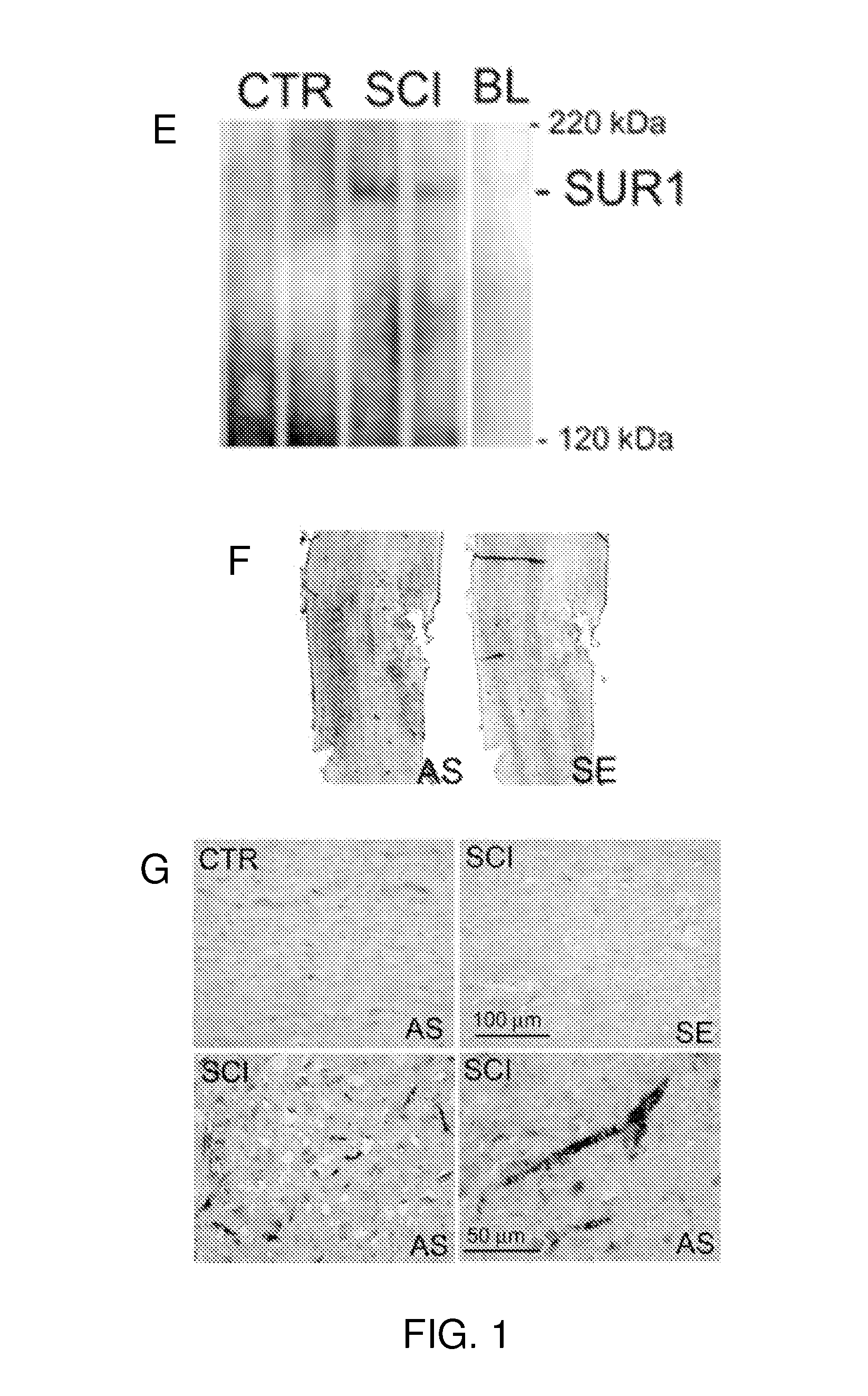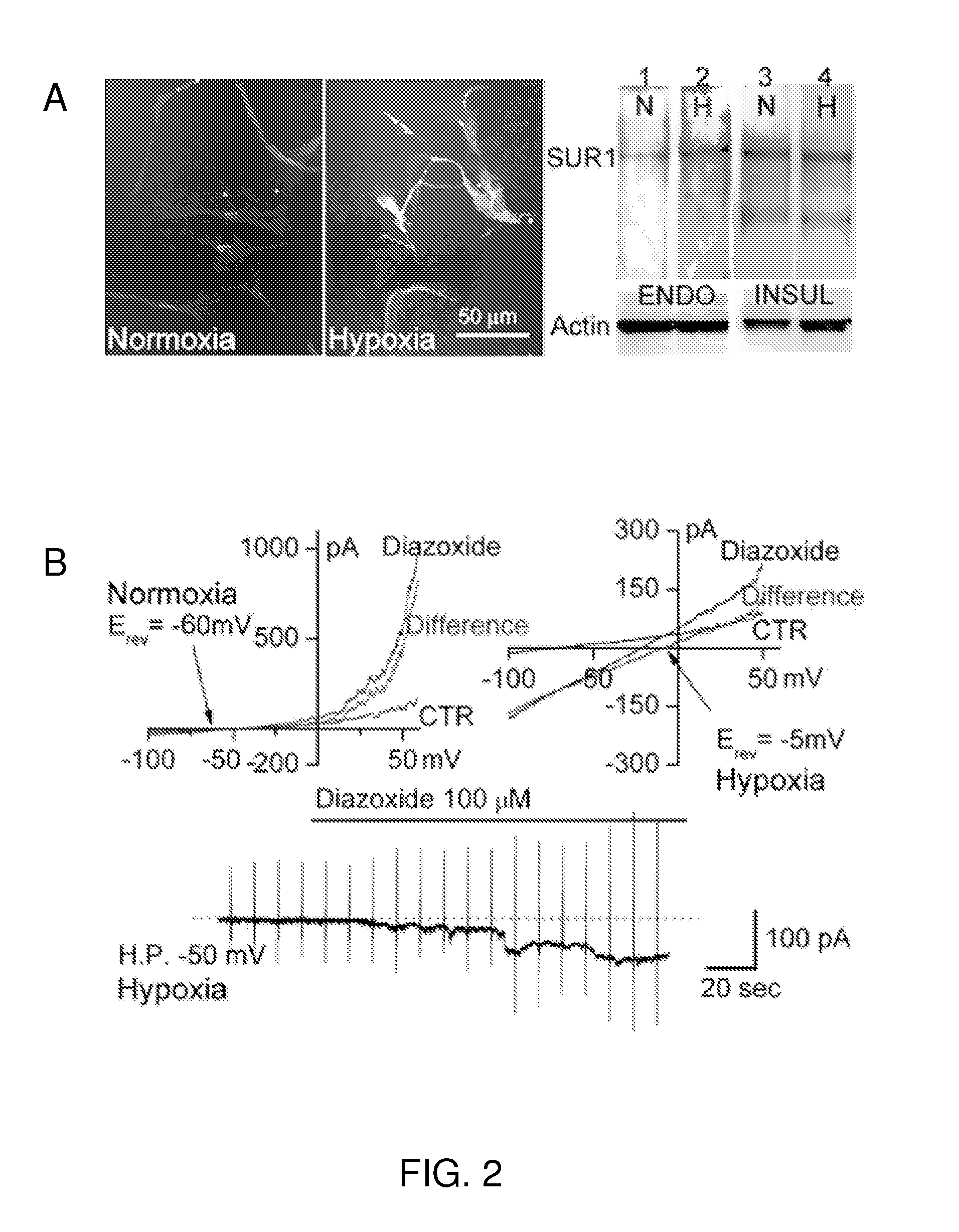Inhibitors of NCCa-ATP channels for therapy
a technology of nccaatp and inhibitors, applied in the field of cell biology, molecular biology, medicine, can solve the problems of physical disruption of spinal cord neurons and axons, deficits in motor, sensory, and autonomic functions, placing significant burdens on healthcare systems, etc., to/or ionic edema, and/or vasogenic edema, and prevent or reduce cytotoxic edema
- Summary
- Abstract
- Description
- Claims
- Application Information
AI Technical Summary
Benefits of technology
Problems solved by technology
Method used
Image
Examples
example 1
Up-Regulation of SUR1 IN SCI
[0350]SUR1 expression was studied in spinal cords of uninjured rats and rats after “severe” SCI (10-gm weight dropped 25 mm; 3-5 rats / group) (Soblosky et al., 2001; Gensel et al., 2006). In controls, low levels of SUR1 expression were found in the dorsal horns (FIG. 1a), due to constitutively expressed KATP channels (Yamashita et al., 1994).
[0351]After unilateral SCI, the lesion itself as well as the pattern of SUR1 expression changed with time and distance from the impact site (FIG. 1a). Early post-SCI (¾ h), the lesion was small and was not immunolabeled by anti-SUR1 antibody (not shown). At 6 h, a necrotic lesion was apparent as a void in the ipsilateral cord, and SUR1 up-regulation was prominent in tissues surrounding the void. At 24 h, the necrotic lesion had enlarged (Nelson et al., 1977; Tator, 1995), SUR1 up-regulation was still apparent in the rim of the necrotic lesion, but now it extended to tissues more distant from the impact site, including ...
example 2
SUR1 in Endothelium is Associated with NCCa-ATP Channel
[0354]SUR1 forms the regulatory subunit of both NCCa-ATP and some KATP channels (Chen et al., 2003). Our previous work demonstrated that, following exposure to hypoxia or ischemia in vivo, up-regulation of SUR1 in astrocytes and neurons is associated with expression of functional NCCa-ATP channels, not KATP channels (Chen et al., 2003; Simard et al., 2006). The same reports also showed up-regulation of SUR1 in capillaries, as was found here with SCI, but the associated channel was not identified. Endothelial cells may normally express KATP channels, but the regulatory subunit of cardiovascular KATP channels is generally SUR2, not SUR1 (Jansen-Olesen et al., 2005). Nevertheless, it was important to determine which of the two channels, KATP or NCCa-ATP, the newly expressed SUR1 was associated with in capillary endothelium.
[0355]Endothelial cell cultures from 3 sources, human brain microvascular, human aorta, and murine brain micro...
example 3
Glibenclamide Block of SUR1—Extravasation of Blood
[0361]To assess the role of SUR1 in SCI, the effect of glibenclamide was studied, which is a sulfonylurea inhibitor that binds with subnanomolar or nanomolar affinity (0.4-4.0 nM) to SUR1 (24). Immediately after injury, animals were implanted with mini-osmotic pumps that delivered either vehicle or glibenclamide (200 ng / h) s.q. Constant infusion of a low-dose of drug was used to achieve sustained occupancy of only high-affinity receptors.
[0362]Cords of vehicle-treated animals examined 24 h post-SCI showed prominent bleeding at the surface and internally, with internal bleeding consisting of a central region of hemorrhage plus numerous distinct petechial hemorrhages at the periphery (FIG. 3a, arrows). By contrast, cords of glibenclamide-treated animals showed visibly less hemorrhage and it was largely confined to the site of impact, with fewer petechial hemorrhages in surrounding tissues (FIG. 3a).
[0363]The amount of extravasated bloo...
PUM
| Property | Measurement | Unit |
|---|---|---|
| weight | aaaaa | aaaaa |
| single-channel conductance | aaaaa | aaaaa |
| single-channel conductance | aaaaa | aaaaa |
Abstract
Description
Claims
Application Information
 Login to View More
Login to View More - R&D
- Intellectual Property
- Life Sciences
- Materials
- Tech Scout
- Unparalleled Data Quality
- Higher Quality Content
- 60% Fewer Hallucinations
Browse by: Latest US Patents, China's latest patents, Technical Efficacy Thesaurus, Application Domain, Technology Topic, Popular Technical Reports.
© 2025 PatSnap. All rights reserved.Legal|Privacy policy|Modern Slavery Act Transparency Statement|Sitemap|About US| Contact US: help@patsnap.com



